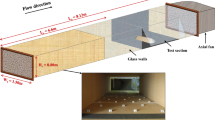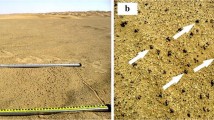Abstract
There are many industrial sites where open aggregate conical piles exist to store granular materials, like coal, industrial residuals, or other minerals. Usually these storage piles are placed in open areas, making them susceptible to wind erosion, which can create health, environmental, and/or economical concerns. It is common to minimize the dust emission through the placement of windbreaks in the vicinity of the storage piles, which reduces the wind speed in the vicinity of the pile’s surface. In this work, some experimental results from a wind tunnel study on the erosion of a conical sand pile, exposed or protected by a fence with porosities of 0, 70, and 83%, are shown. For the sheltered cases, the windbreak was placed at several distances from the pile’s leading edge, ranging from H to 4H, where H is the initial height of the non-eroded pile. The evolution of the shape of the sand pile is shown, at different instances in time, and the pile deformation quantified, using a novel experimental setup developed for wind erosion studies. This information might be regarded as a useful dataset for the benchmark of computational models aiming to produce the transient simulation of the aeolian erosion of stockpiles. The CFD results are comprised of the modeling of several experimental scenarios. The computational results for the surface wind velocity show a good correlation with the initial deformation of the pile. Based on the results, the isocontours of (u s /u r ) presented might be regarded as a good basis for the estimation of the pile shear velocity.
Similar content being viewed by others
References
Park C-W, Lee S-J (2002) Verification of the shelter effect of a windbreak on coal piles in the POSCO open storage yards at the Kwang-Yang Works. Atmos Environ 36: 2171–2185
Ferreira AD, Viegas DX, Sousa ACM (2003) Full-scale measurements for evaluation of coal dust release from train wagons with two different shelter covers. J Wind Eng Ind Aerodyn 91: 1271–1283
Stunder B, Arya S (1988) Windbreak effectiveness for storage pile fugitive dust control: a wind tunnel study. J Air Pollut Control Assoc 38: 135–143
Cornelis WM, Gabriels D (2005) Optimal windbreak design for wind-erosion control. J Arid Environ 61: 315–332
Badr T, Harion JL (2007) Effect of aggregate storage piles configuration on dust emissions. Atmos Environ 41: 360–368
Santiago JL, Martin F, Cuerva A, Bezdenejnykh N, Sanz-Andrés A (2007) Experimental and numerical study of wind flow behind windbreaks. Atmos Environ 41: 6406–6420
Toraño J, Torno S, Diego I, Menendez M, Gent M (2009) Dust emission calculations in open storage piles protected by means of barriers, CFD and experimental tests. Envir Fluid Mech 9: 493–507
Diego I, Pelegry A, Torno S, Toraño J, Menendez M (2009) Simultaneous CFD evaluation of wind flow and dust emission in open storage piles. Appl Math Model 33: 3197–3207
Turpin C, Harion JL (2009) Numerical modeling of flow structures over various flat-topped stockpiles height: Implications on dust emissions. Atmos Environ 43: 5579–5587
EPA (2006) Industrial Wind Erosion (chapter 13). http://www.epa.gov/ttn/chief/ap42/ch13/final/c13s0205.pdf
Ghazavi M, Hosseini M, Mollanouri M (2008) A comparison between angle of repose and friction angle of sand. In: Proceedings of the 12th international conference of international association for computer methods and advances in geomechanics (IACMAG), Goa, India, pp 1272–1275
Bagnold RA (1941) The physics of blown sand and desert dunes. Chapman & Hall, London, p 265
White BR (1996) Laboratory simulation of aeolian sand transport and physical modeling of flow around dunes. Ann Arid Zone 35(3): 187–213
Cermak JE, Arya SPS (1970) Problems of atmospheric shear flows and their laboratory simulation. Boundary-Layer Meteorol 1: 40–60
Hagen LJ (1999) Assessment of wind erosion parameters using wind tunnels. In: Stott DE, Mohtar RH, Steinhardt GA (eds) Sustaining the global farm, proceedings of 10th international soil conservation organization conference, 24–29 May 1999, Purdue University, West Lafayette, IN, pp 742–746
Ferreira AD, Oliveira RA (2009) Wind erosion of sand placed inside a rectangular box. J Wind Eng Ind Aerodyn 97: 1–10
Dimetix http://www.dimetix.com
Lancaster N (1995) Geomorphology of desert dunes. Routledge, London, p 244
Durán O, Herrmann H (2006) Modelling of saturated sand flux. J Stat Mech Theory Exp. doi:10.1088/1742-5468/2006/07/P07011
Wang H, Takle ES, Shen J (2001) Shelterbelts and windbreaks: mathematical modeling and computer simulations of turbulent flows. Ann Rev Fluid Mech 22: 549–586
Lee S-J, Kim H-B (1999) Laboratory measurements of velocity and turbulence field behind porous fences. J Wind Eng Ind Aerodyn 80: 311–326
Dong Z, Liu X, Wang H, Wang X (2003) Aeolian sand transport: a wind tunnel model. Sediment Geol 161: 71–83
Pye K, Tsoar H (2009) Aeolian sand and sand dunes. Springer, Berlin, p 458
Wilson JD (1987) On the choice of a windbreak porosity profile. Boundary-Layer Meteorology 38: 37–49
Author information
Authors and Affiliations
Corresponding author
Rights and permissions
About this article
Cite this article
Ferreira, A.D., Lambert, R.J. Numerical and wind tunnel modeling on the windbreak effectiveness to control the aeolian erosion of conical stockpiles. Environ Fluid Mech 11, 61–76 (2011). https://doi.org/10.1007/s10652-010-9176-x
Received:
Accepted:
Published:
Issue Date:
DOI: https://doi.org/10.1007/s10652-010-9176-x




